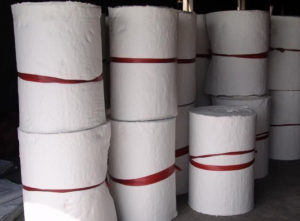Why not Use Refractory Fiber Products in Cement Industry

Refractory fiber is a kind of insulating refractory which is widely used in steel, ceramics and other industries. In the short term, the refractory fiber has good insulation effect, but the heat insulation performance of the refractory fiber will deteriorate gradually due to the pulverization of the fiber. What is more, the powdered fiber is harmful to human body. Therefore, fiber insulation refractories are not recommended for use in the cement industry.

The main problems of refractory fibers are thermal deterioration and environmental pollution. When heated, the amorphous fibers will separate out the crystals, causing the fibers to shrink and pulverize. Fiber contraction for the first time in 800 ~ 1000C, the reason is that PAM of aluminum silicate glass phase change, The second time in 1200 ℃, the reason is to melt.
The temperature of amorphous refractory fiber increased after adding zirconia. Refractory crystal fibers are used at higher temperatures. Above 1300C,
however, even a refractory crystal fiber can be due to grain growth pulverization.
As the temperature increases or the atmosphere reverses to the original state, the life of the refractory fiber decreases obviously. In addition, water vapor, alkali, or other volatile substances, as well as the scouring of air can significantly shorten the life of the fiber.
After pulverization, the fiber becomes a fine needle like substance that is easy to disperse, which not only loses the effect of heat insulation, but also can cause the discomfort of human skin, mouth, nose, throat and other parts. The European Union has listed refractory fibre as a possible carcinogen.In the future, China may also legislate to regulate and restrict the production and use of refractory fiber.



